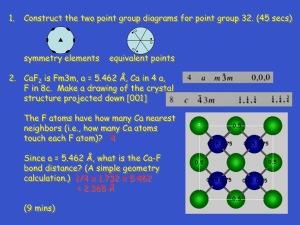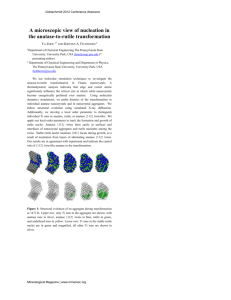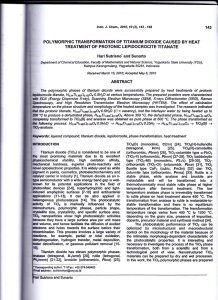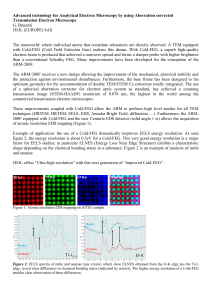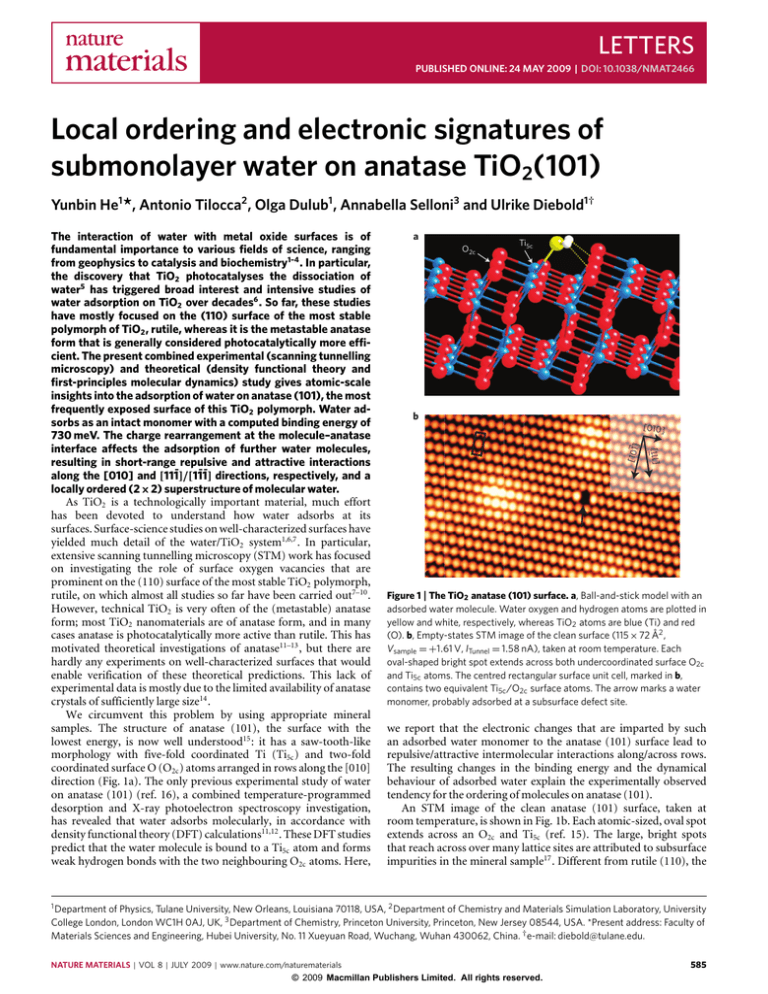
LETTERS
PUBLISHED ONLINE: 24 MAY 2009 | DOI: 10.1038/NMAT2466
Local ordering and electronic signatures of
submonolayer water on anatase TiO2(101)
Yunbin He1 *, Antonio Tilocca2 , Olga Dulub1 , Annabella Selloni3 and Ulrike Diebold1†
O2c
Ti5c
b
[010]
¬
[111]
a
[101¬]
The interaction of water with metal oxide surfaces is of
fundamental importance to various fields of science, ranging
from geophysics to catalysis and biochemistry1–4 . In particular,
the discovery that TiO2 photocatalyses the dissociation of
water5 has triggered broad interest and intensive studies of
water adsorption on TiO2 over decades6 . So far, these studies
have mostly focused on the (110) surface of the most stable
polymorph of TiO2 , rutile, whereas it is the metastable anatase
form that is generally considered photocatalytically more efficient. The present combined experimental (scanning tunnelling
microscopy) and theoretical (density functional theory and
first-principles molecular dynamics) study gives atomic-scale
insights into the adsorption of water on anatase (101), the most
frequently exposed surface of this TiO2 polymorph. Water adsorbs as an intact monomer with a computed binding energy of
730 meV. The charge rearrangement at the molecule–anatase
interface affects the adsorption of further water molecules,
resulting in short-range repulsive and attractive interactions
along the [010] and [111̄]/[11̄1̄] directions, respectively, and a
locally ordered (2×2) superstructure of molecular water.
As TiO2 is a technologically important material, much effort
has been devoted to understand how water adsorbs at its
surfaces. Surface-science studies on well-characterized surfaces have
yielded much detail of the water/TiO2 system1,6,7 . In particular,
extensive scanning tunnelling microscopy (STM) work has focused
on investigating the role of surface oxygen vacancies that are
prominent on the (110) surface of the most stable TiO2 polymorph,
rutile, on which almost all studies so far have been carried out7–10 .
However, technical TiO2 is very often of the (metastable) anatase
form; most TiO2 nanomaterials are of anatase form, and in many
cases anatase is photocatalytically more active than rutile. This has
motivated theoretical investigations of anatase11–13 , but there are
hardly any experiments on well-characterized surfaces that would
enable verification of these theoretical predictions. This lack of
experimental data is mostly due to the limited availability of anatase
crystals of sufficiently large size14 .
We circumvent this problem by using appropriate mineral
samples. The structure of anatase (101), the surface with the
lowest energy, is now well understood15 : it has a saw-tooth-like
morphology with five-fold coordinated Ti (Ti5c ) and two-fold
coordinated surface O (O2c ) atoms arranged in rows along the [010]
direction (Fig. 1a). The only previous experimental study of water
on anatase (101) (ref. 16), a combined temperature-programmed
desorption and X-ray photoelectron spectroscopy investigation,
has revealed that water adsorbs molecularly, in accordance with
density functional theory (DFT) calculations11,12 . These DFT studies
predict that the water molecule is bound to a Ti5c atom and forms
weak hydrogen bonds with the two neighbouring O2c atoms. Here,
Figure 1 | The TiO2 anatase (101) surface. a, Ball-and-stick model with an
adsorbed water molecule. Water oxygen and hydrogen atoms are plotted in
yellow and white, respectively, whereas TiO2 atoms are blue (Ti) and red
(O). b, Empty-states STM image of the clean surface (115 × 72 Å2 ,
Vsample = +1.61 V, ITunnel = 1.58 nA), taken at room temperature. Each
oval-shaped bright spot extends across both undercoordinated surface O2c
and Ti5c atoms. The centred rectangular surface unit cell, marked in b,
contains two equivalent Ti5c /O2c surface atoms. The arrow marks a water
monomer, probably adsorbed at a subsurface defect site.
we report that the electronic changes that are imparted by such
an adsorbed water monomer to the anatase (101) surface lead to
repulsive/attractive intermolecular interactions along/across rows.
The resulting changes in the binding energy and the dynamical
behaviour of adsorbed water explain the experimentally observed
tendency for the ordering of molecules on anatase (101).
An STM image of the clean anatase (101) surface, taken at
room temperature, is shown in Fig. 1b. Each atomic-sized, oval spot
extends across an O2c and Ti5c (ref. 15). The large, bright spots
that reach across over many lattice sites are attributed to subsurface
impurities in the mineral sample17 . Different from rutile (110), the
1 Department of Physics, Tulane University, New Orleans, Louisiana 70118, USA, 2 Department of Chemistry and Materials Simulation Laboratory, University
College London, London WC1H 0AJ, UK, 3 Department of Chemistry, Princeton University, Princeton, New Jersey 08544, USA. *Present address: Faculty of
Materials Sciences and Engineering, Hubei University, No. 11 Xueyuan Road, Wuchang, Wuhan 430062, China. † e-mail: diebold@tulane.edu.
NATURE MATERIALS | VOL 8 | JULY 2009 | www.nature.com/naturematerials
© 2009 Macmillan Publishers Limited. All rights reserved.
585
NATURE MATERIALS DOI: 10.1038/NMAT2466
LETTERS
a
[010
[101¬]
]
b
c
0.24 ML
d
0.8
Height (Å)
Height (Å)
0.8
0.4
0
~3.9 Å
0
10
Length (Å)
20
0.4
0
0
10
~7.9 Å
20
30
Length (Å)
Figure 2 | Hopping and short-range ordering of water on anatase (101).
a,b, Two consecutive STM images of 0.11 ML of water on anatase (101)
(173 × 63 Å2 , +3.5 V, 0.45 nA) taken at a sample temperature of 190 K.
The green and black arrows indicate ordered water clusters along the [11̄1̄]
and [111̄] directions, respectively. c, Difference image (a,b); the white
arrows indicate the hopping direction of selected water molecules. d, Line
profiles of a water molecule, taken across the blue line in b, and of two
adsorbed water molecules separated by an empty lattice site (red line in b).
clean anatase (101) surface shows very few atomic-size defects. In
particular there are hardly any O vacancies, which are known to
have an important role in the surface chemistry of rutile (110)
(refs 6, 7). In fact, our DFT calculations predict that O vacancies
on anatase TiO2 (101) have a substantially lower formation energy
at subsurface than at surface sites, and STM results from a reduced
anatase sample show that intrinsic defects reside predominantly in
the subsurface region17 . The STM image in Fig. 1b also shows an
isolated black spot, with a brighter spot on either side (marked
by an arrow). As we will argue below, such a white–black–white
(w–b–w) feature is attributed to an adsorbed water monomer. At
room temperature, the number of these w–b–w features is small,
and their density is higher for more reduced samples. For the crystal
used here, the saturation coverage is about 0.005 monolayers (where
one monolayer (ML) corresponds to the number of Ti5c sites per
unit area). Water desorbs slightly below room temperature from the
defect-free surface16 , but the above-mentioned subsurface defects
increase the adsorption energy of water molecules. Thus, the water
molecule in Fig. 1b probably sits on a site with a subsurface defect.
When the clean anatase (101) surface is exposed to water
at low temperatures, the number of w–b–w features increases
(Fig. 2). As shown in the line profile across one such feature, the
apparent depression is ∼1 Å deep. The apparent elevation at each
neighbouring lattice site extends towards the adjacent row in the
[101̄] direction. Figure 2 shows two consecutive STM images with a
586
Figure 3 | Ordered water overlayer on anatase (101). STM image
(118 × 127 Å2 , +1.49 V, 0.28 nA) of the anatase TiO2 (101) surface after
water adsorption at 150 K. The water coverage is 0.24 ML. The water
forms a weakly ordered overlayer with (2 × 2) symmetry as indicated by
the unit cell. The blue arrow indicates the double periodicity along the
[010] direction.
surface coverage of 0.11 ML. At the sample temperature where the
images were taken (190 K), the w–b–w features show some mobility.
They always hop as a whole unit. This appears more clearly in the
difference image in Fig. 2c. (The two images in Fig. 2a,b are part of
a longer series, which follows the motion of the w–b–w features, see
Supplementary Movie S1.)
A short-range ordering is also apparent in Fig. 2: the w–b–w
features tend to align along the [111̄] and [11̄1̄] directions, that is,
along the diagonal of the centred unit cell (see also Supplementary
Fig. S1). Interestingly, we rarely observe two neighbouring black
spots sitting right next to each other on one row, and the red
line profile in Fig. 2d shows that the black spots are separated by
two lattice spacings along [010]. This is also true for higher water
coverages (Fig. 3), where, instead of longer, black rows, STM shows
lines with alternating w–b contrast on neighbouring sites. This
double periodicity along the rows, combined with the tendency to
have a w–b–w neighbour in the next row, results in the formation
of a superstructure with (2×2) symmetry. The STM image in Fig. 3
shows patches of this superstructure.
These experimental results are consistent with each w–b–w unit
representing a water monomer (see also Supplementary Fig. S2),
but alternative possibilities need to be considered. Water–water
interactions are usually attractive, yet the double periodicity along
the [010] direction would point towards a repulsive interaction
between water monomers. Is it possible that, instead of an isolated
monomer, each w–b–w unit represents a particularly stable water
aggregate, containing two, three or even more molecules13,18,19 ?
Such a cluster should contain a water molecule in a special
configuration that gives rise to the prominent black spot in
empty-states STM. In addition, the water clusters should not break
up when hopping across the surface, and they should somehow
preserve their special configuration when aligning themselves into
rows. On reduced surfaces with subsurface defects, we observe
w–b–w features even at 400 K. The typical strength of a H-bond is
∼0.2 eV. Thus, it is quite unlikely that a H-bonded water cluster
NATURE MATERIALS | VOL 8 | JULY 2009 | www.nature.com/naturematerials
© 2009 Macmillan Publishers Limited. All rights reserved.
NATURE MATERIALS DOI: 10.1038/NMAT2466
b
c
d
10
Distance along [010] (Å)
a
LETTERS
< 3.3
3.5
3.6
3.75
3.9
4.0
5
0
¬5
¬10
4.0
3.5
3.0
Height (Å)
Figure 4 | Theoretical results for an adsorbed water monomer on anatase (101). a,b, Optimized geometry (top view) (a) and isosurface (b) of the charge
density difference resulting from adsorption of a water molecule. Positive (electron excess) and negative (electron deficit) lobes are shown in blue and
yellow, respectively. c, Simulated constant density (1 × 10−4 electrons per bohr3 ) image, determined from the integrated local density of states in an energy
window of 2.75 eV from the conduction band minimum. d, Height profile along the line indicated in c; z values in the plot and the height profile are
referenced to the position of the Ti5c atoms.
1A
2A
2B
2C
[010]
[101]
0
+33 meV
+3 meV
¬7 meV
3A
3B
3C
4A
+40 meV
+17 meV
¬1 meV
0
¬
[101]
Figure 5 | Calculated adsorption configurations of water on anatase (101). Optimized structures of a water monomer (1A), and of different clusters of
two (2A, 2B and 2C), three (3A, 3B and 3C) and four (4A) water molecules. The adsorption energy for each configuration is given in millielectronvolts per
water molecule, relative to the adsorbed monomer; a positive value indicates that the configuration is less stable relative to isolated monomers.
could be stable at and even above room temperature; nevertheless,
this possibility was explored using Car–Parrinello20 first-principles
molecular dynamics (FPMD) simulations.
The computed adsorption structure of an isolated H2 O molecule
is shown in Fig. 4a: the water oxygen forms a dative bond with a
surface Ti5c , whereas the hydrogens form two weak H-bonds with
bridging oxygens (RO–O = 3.15 Å; RH–O = 2.30 Å). Its adsorption
energy is computed as −730 meV, where the negative energy means
the adsorption is exothermic. In the simulated STM images (Fig. 4c
and Supplementary Fig. S3), a bright feature is observed at the
position of the water molecule, displaced towards [101̄] with respect
to the Ti5c adsorption site. The Ti5c adsorption site appears as a
dark spot, whereas the two neighbouring Ti5c sites in the same row
and especially the two Ti5c sites in the adjacent row on the right
give rise to further bright features. Only the monomer shows an
apparent depression at a Ti5c site that is deeper than a regular lattice
NATURE MATERIALS | VOL 8 | JULY 2009 | www.nature.com/naturematerials
© 2009 Macmillan Publishers Limited. All rights reserved.
587
NATURE MATERIALS DOI: 10.1038/NMAT2466
LETTERS
site. Water dimers have a very different appearance; for example,
the structure recently proposed by Mattioli et al.13 shows a weak
feature extending two lattice sites along a single row. Similarly, all
of the statistically relevant configurations of a water trimer give STM
contrasts that do not resemble the experimental STM images (see
Supplementary Fig. S4). In the calculated as well as the experimental
images, each water molecule affects a relatively large area, suggesting
that the adsorbed water molecule modifies the electron charge
distribution at surrounding Ti5c sites. Figure 4b shows the electronic
charge density difference induced by an adsorbed water molecule.
The yellow lobes enclose regions where the density is reduced on
adsorption. Such a reduction is clearly present on both of the two
Ti5c atoms in the adjacent row. It is attributed to the H-bonds
between the water molecule and the two O2c atoms bonded to the
Ti5c adsorption sites in the adjacent row.
FPMD simulations of an isolated adsorbed water molecule (see
Supplementary Fig. S5) show that the molecular orientation is
largely maintained along the trajectory, with the dipole always
pointing roughly towards [101̄]. In contrast, when a second H2 O
is adsorbed on an adjacent Ti5c site along the same row, the
FPMD traces (see Supplementary Fig. S5, centre) show a marked
in-plane and out-of-plane motion of the two molecules, suggesting
intermolecular interactions. This is confirmed by the optimized
structure (2A in Fig. 5), in which one of the two molecules is turned
sideways, with a hydrogen pointing upward. Correspondingly, the
adsorption energy per molecule (also reported in Fig. 5) is slightly
reduced from that of an isolated monomer, indicating a small
but significant repulsion between the two adjacent molecules. This
repulsive interaction is largely removed when the two molecules
are adsorbed at next-nearest-neighbouring Ti5c sites along the same
row, see structure 2B in Fig. 5, in agreement with the experimentally
observed double periodicity. In contrast, the adsorption of two
molecules at neighbouring Ti5c sites in adjacent rows (structure 2C
in Fig. 5) is slightly favoured, probably because the reduced charge
density at these Ti5c sites renders them slightly more acidic. A similar
effect was observed in other adsorbate/oxide systems21 .
Our calculations for three and four adsorbed water molecules
(Fig. 5 bottom row, and Supplementary Fig. S5) confirm the
occurrence of (weak) attractive interactions between neighbouring
water molecules along [111̄]/[11̄1̄], and repulsive interactions
between molecules at neighbouring Ti5c sites along [010]. Consider,
for example, the adsorption energies of three water molecules:
adsorption is least favoured when all molecules are adsorbed in
a single row (structure 3A), it becomes slightly stronger when
one molecule is moved to an adjacent row (3B) and further
increases when another molecule is moved one lattice spacing
away (3C). Although the computed energy differences for the
various investigated configurations are small, they are in excellent
agreement with the short-range ordering observed in STM.
This interplay between substrate-mediated intermolecular
attractive and repulsive interactions that determines ordering at low
water coverage is a novel effect. On metal surfaces the hydrogen
bonding between water molecules results in clusters in various
configurations18,19,22 . It is well established1,4 that the surface oxygen
atoms (Os ) on metal oxides influence the adsorption properties
by providing extra possibilities for H-bonding. The formation of
ordered overlayers has been observed on some oxide surfaces23,24 ,
but usually it is either the registry with the substrate, or the
H-bonding between water molecules, that dictates the formation
of such ordering, rather than substrate-mediated interactions. The
effect reported here originates from the stronger water–surface
(730 meV) versus water–water interaction (for which an upper limit
is the cohesive energy of ice, ∼580 meV), and the possibility for each
water molecule to form two H-bonds with the anatase (101) surface.
These features are not present on the other TiO2 polymorph, rutile
(110), where STM shows water molecules adsorbed right next
588
to each other along Ti5c rows10 , and DFT calculations indicate
intermolecular H-bonding and potentially dissociation even on the
stoichiometric surface8,25,26 . More generally, the situation described
in this work—namely, that an Os atom can accommodate only one
H-bond from an adsorbed water molecule, and that, after arrival
of a second water molecule in its neighbourhood, the competition
between the two molecules for the same Os atom weakens the
H-bond of the first one and effectively lowers its adsorption
energy—could be a general feature that has to be taken into account
when considering water on oxides.
Methods
Experimental details. All experiments were carried out in an ultrahigh-vacuum
chamber with a base pressure of ∼1 × 10−10 mbar (SPECS GmbH). It is equipped
with a variable-temperature Aarhus STM, and facilities for low-energy electron
diffraction, X-ray photoelectron spectroscopy, surface cleaning and gas dosing.
In situ sample cleaning was achieved by cycles of Ar+ ion sputtering and annealing
to 600 ◦ C. The anatase sample was a natural mineral crystal, cleaved ex situ. Water
was cleaned by repeated freeze–pump–thaw cycles and the purity of water vapour
was checked by mass spectrometry. It was dosed by backfilling the chamber through
a leak valve with the sample in the cold stage of the STM. The tip was retracted
by ∼1 mm from the sample to avoid tip shadowing effects. Typically, water was
dosed at a sample temperature between 100 and 130 K with nominal dosages of
less than one Langmuir (L, where 1 L equals a dose of 1 × 10−6 torr s). STM was
carried out in the constant-current mode, and empty states were typically imaged
with positive sample bias voltages in the range of 0.6–3.5 V and tunnelling currents
between 0.2 and 1.1 nA.
Theoretical details. For the DFT calculations, we used the
Perdew–Burke–Ernzerhof exchange–correlation functional27 and ultrasoft
pseudopotentials28 . Valence electrons included the O 2s, 2p and Ti 3s, 3p, 3d,
4s shells; the energy cutoffs for the smooth part of the wavefunctions and the
augmented density were 25 and 200 Ryd, respectively; k-sampling was restricted
to only the 0 point. The stoichiometric anatase (101) surface was modelled
as a periodically repeated slab including four Ti8 O16 layers, with a vertical
separation between slabs of ∼12 Å. A (1 × 4) supercell with an exposed surface
area of 10.24 × 15.14 Å2 was used. Such a large surface cell enables us to reduce
the interaction between periodic images of the adsorbed molecules, effectively
modelling isolated molecules. In all simulations, the atoms of the bottom layer
were fixed to their equilibrium bulk positions, and water was adsorbed only on
the upper surface. The average adsorption energy per water molecule is defined
as Eads = [E(slab + nH2 O) − E(slab) − nE(H2 O)]/n, where E(slab + nH2 O) and
E(slab) are the energy of the slab with and without water molecules, respectively,
E(H2 O) is the energy of a gas-phase water molecule and n is the number of water
molecules adsorbed. FPMD trajectories of 10–15 ps at 160 K were carried out to
probe the configurational space of the adsorbed molecules; selected configurations
extracted from these trajectories were optimized using the PWSCF code of the
Quantum-Espresso package29 , until the largest component in the ionic forces was
less than 25 meV Å−1 . These optimized structures were then used as input for the
calculations of empty-state STM images30 .
Received 22 December 2008; accepted 30 April 2009;
published online 24 May 2009
References
1. Henderson, M. A. The interaction of water with solid surfaces: Fundamental
aspects revisited. Surf. Sci. Rep. 46, 1–308 (2002).
2. Verdaguer, A., Sacha, G. M., Bluhm, H. & Salmeron, M. Molecular structure
of water at interfaces: Wetting at the nanometer scale. Chem. Rev. 106,
1478–1510 (2006).
3. Al-Abadleh, H. A. & Grassian, V. H. Oxide surfaces as environmental interfaces.
Surf. Sci. Rep. 52, 63–161 (2003).
4. Thiel, P. A. & Madey, T. E. The interaction of water with solid surfaces:
Fundamental aspects. Surf. Sci. Rep. 7, 211–385 (1987).
5. Fujishima, A. & Honda, K. Electrochemical photolysis of water at a
semiconductor electrode. Nature 238, 37–38 (1972).
6. Diebold, U. The surface science of titanium dioxide. Surf. Sci. Rep. 48,
53–229 (2003).
7. Pang, C. L., Lindsay, R. & Thornton, G. Chemical reactions on rutile TiO2 (110).
Chem. Soc. Rev. 37, 2328–2353 (2008).
8. Wendt, S. et al. Formation and splitting of paired hydroxyl groups on reduced
TiO2 (110). Phys. Rev. Lett. 96, 066107 (2006).
9. Zhang, Z., Bondarchuk, O., Kay, B. D., White, J. M. & Dohnalek, Z. Imaging
water dissociation on TiO2 (110): Evidence for inequivalent geminate OH
groups. J. Phys. Chem. B 110, 21840–21845 (2006).
10. Brookes, I. M., Muryn, C. A. & Thornton, G. Imaging water dissociation on
TiO2 (110). Phys. Rev. Lett. 87, 266103 (2001).
NATURE MATERIALS | VOL 8 | JULY 2009 | www.nature.com/naturematerials
© 2009 Macmillan Publishers Limited. All rights reserved.
NATURE MATERIALS DOI: 10.1038/NMAT2466
11. Vittadini, A., Selloni, A., Rotzinger, F. P. & Graetzel, M. Structure and
energetics of water adsorbed at TiO2 anatase (101) and (001) surfaces.
Phys. Rev. Lett. 81, 2954–2957 (1998).
12. Tilocca, A. & Selloni, A. Vertical and lateral order in adsorbed water layers on
anatase TiO2 (101). Langmuir 20, 8379–8384 (2004).
13. Mattioli, G., Filippone, F., Caminiti, R. & Bonapasta, A. A. Short hydrogen
bonds at the water/TiO2 (anatase) interface. J. Phys. Chem. C 112,
13579–13586 (2008).
14. Diebold, U., Ruzycki, N., Herman, G. S. & Selloni, A. One step towards
bridging the materials gap: Surface studies of TiO2 anatase. Catal. Today 85,
93–100 (2003).
15. Gong, X. -Q., Selloni, A., Batzill, M. & Diebold, U. Steps on anatase TiO2 (101).
Nature Mater. 5, 665–670 (2006).
16. Herman, G. S., Dohnalek, Z., Ruzycki, N. & Diebold, U. Experimental
investigation of the interaction of water and methanol with anatase-TiO2 (101).
J. Phys. Chem. B 107, 2788–2795 (2003).
17. He, Y. B., Dulub, O., Cheng, H. Z., Selloni, A. & Diebold, U. Evidence for
the predominance of subsurface defects on reduced anatase TiO2 (101).
Phys. Rev. Lett. 102, 106105 (2009).
18. Cerda, J. et al. Novel water overlayer growth on Pd(111) characterized with
scanning tunneling microscopy and density functional theory. Phys. Rev. Lett.
93, 116101 (2004).
19. Michaelides, A. & Morgenstern, K. Ice nanoclusters at hydrophobic metal
surfaces. Nature Mater. 6, 597–601 (2007).
20. Car, R. & Parrinello, M. Unified approach for molecular dynamics and
density-functional theory. Phys. Rev. Lett. 55, 2471–2474 (1985).
21. Wang, Y. et al. Tuning the reactivity of oxide surfaces by charge-accepting
adsorbates. Angew. Chem. Int. Ed. 46, 7315–7318 (2007).
22. Mitsui, T., Rose, M. K., Fomin, E., Ogletree, D. F. & Salmeron, M. Water
diffusion and clustering on Pd(111). Science 297, 1850–1852 (2002).
LETTERS
23. Ferry, D. et al. The properties of a two-dimensional water layer on MgO(001).
Surf. Sci. 377–379, 634–638 (1997).
24. Dulub, O., Meyer, B. & Diebold, U. Observation of the dynamical change
in a water monolayer adsorbed on a ZnO surface. Phys. Rev. Lett. 95,
136101 (2005).
25. Lindan, P. J. D. & Zhang, C. Exothermic water dissociation on the rutile
TiO2 (110) surface. Phys. Rev. B 72, 075439 (2005).
26. Kowalski, P. M., Meyer, B. & Marx, D. Composition, structure, and stability
of the rutile TiO2 (110) surface: Oxygen depletion, hydroxylation, hydrogen
migration, and water adsorption. Phys. Rev. B 79, 115410 (2009).
27. Perdew, J. P., Burke, K. & Ernzerhof, M. Generalized gradient approximation
made simple. Phys. Rev. Lett. 77, 3865–3868 (1996).
28. Vanderbilt, D. Soft self-consistent pseudopotentials in a generalized eigenvalue
formalism. Phys. Rev. B 41, 7892–7895 (1990).
29. Baroni, S., Giannozzi, P., De Gironcoli, S. & Dal Corso, A. Quantum ESPRESSO
v. 3.2.3, <http://www.pwscf.org>.
30. Tersoff, J. & Hamann, D. R. Theory of the scanning tunneling microscope.
Phys. Rev. B 31, 805–813 (1985).
Acknowledgements
This work was supported by DoE award DE-FG02-05ER15702. We thank C. Di Valentin
for participating in the early stages of this project and H. Cheng for the constant density
STM program. A.T. thanks the UK’s Royal Society for financial support.
Additional information
Supplementary information accompanies this paper on www.nature.com/naturematerials.
Reprints and permissions information is available online at http://npg.nature.com/
reprintsandpermissions. Correspondence and requests for materials should be
addressed to U.D.
NATURE MATERIALS | VOL 8 | JULY 2009 | www.nature.com/naturematerials
© 2009 Macmillan Publishers Limited. All rights reserved.
589


